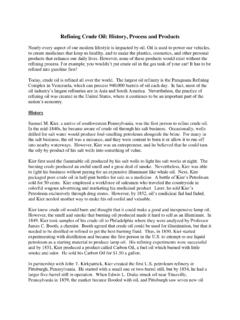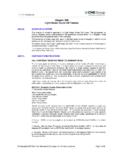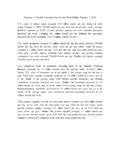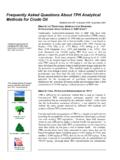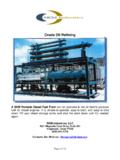Transcription of agribusiness handbook - Food and Agriculture …
1 handbook agribusiness Sunflower / Crude and Refined Oils agribusiness handbook Sunflower Crude and Refined Oils Please address comments and enquiries to: Investment Centre Division Food and Agriculture Organization of the United Nations (FAO). handbook agribusiness Sunflower Crude and Refined Oils Design and page layout Alberto Pedro Di Santo This handbook is part of a series of agribusiness manuals prepared by the FAO Investment Centre Division, in collaboration with FAO's Rural Infrastructure and Agro-Industries Division. It was prepared for the EBRD. agribusiness team, under the FAO/EBRD programme of cooperation. The production of the manuals was financed by FAO and by the EBRD.
2 Multidonor Early Transition Countries Fund and the Western Balkans Fund. The purpose of this handbook is to help agribusiness bankers and potential investors in the Early Transition countries (ETCs) and the Western Balkan countries (WBCs) to acquire basic knowledge about the technical features of the sunflower seed sector and to become acquainted with recent economic trends in the sector around the world, with a special focus on the ETCs and the WBCs. This volume was prepared by Inna Punda, FAO agribusiness Expert, and reviewed by Dmitry Prikhodko, Economist, FAO Investment Centre Division, as well as by members of the EBRD agribusiness team.
3 Electronic copies can be downloaded from , where a database of agribusiness companies, including sunflower seed processing companies that operate in the ETCs and the WBCs, is also available. Please send comments and suggestions for a future edition of the manual to The designations employed and the presentation of material in this information product do not imply the expression of any opinion whatsoever on the part of the Food and Agriculture Organization of the United Nations (FAO) concerning the legal or development status of any country, territory, city or area or of its authorities, or concerning the delimitation of its frontiers or boundaries.
4 The mention of specific companies or products of manufacturers, whether or not these have been patented, does not imply that these have been endorsed or recommended by FAO in preference to others of a similar nature that are not mentioned. The views expressed in this information product are those of the author(s) and do not necessarily reflect the views of FAO. All rights reserved. Reproduction and dissemination of material in this information product for educational or other non-commercial purposes are authorized without any prior written permission from the copyright holders provided the source is fully acknowledged. Reproduction of material in this information product for resale or other commercial purposes is prohibited without written permission of the copyright holders.
5 Applications for such permission should be addressed to: Director Investment Centre Division FAO. Viale delle Terme di Caracalla, 00153 Rome, Italy or by e-mail to: FAO 2010. TABLE OF CONTENTS. INTRODUCTION 5. 1. SUNFLOWER CULTIVATION 7. Key production parameters 8. Total world production and main producers 9. Key production costs and margins 12. Sunflower seed sale prices 12. International trade in sunflower seeds 13. 2. SUNFLOWER SEED PROCESSING 15. Sunflower seed processing into oil 15. Conversion factors from raw material 18. Oil composition and physical properties 19. Key processing costs and margins 19. World production of sunflower oil and main producing countries 21.
6 Sunflower oil prices 24. Sunflower oil domestic use 25. International trade in sunflower oil 26. 3. SUNFLOWER SEED PRODUCTION AND PROCESSING IN. THE WESTERN BALKAN COUNTIES (WBCs) AND THE EARLY. TRANSITION COUNTRIES (ETCs). 29. Production of sunflower seed in the WBCs and the ETCs 29. Production of sunflower oil in the WBCs and the ETCs 33. Investment projects 37. 4. FURTHER READING 39. INTRODUCTION. The sunflower plant originated in western North America. It is thought to have been domesticated around 1000 by Native Americans. Spanish explorers brought the sunflower to Europe in 1510. However, it was not until the late 1800s, when the flower was introduced in the the Russian Federation, that the sunflower became a food crop.
7 In 1860, Russian farmers made significant improvements in the way that the sunflower was cultivated. At that time, they became the world's largest producer of sunflower seeds. Thousands of years ago, people in many regions began to process vegetable oils, utilizing whatever foodstuffs they had on hand to obtain oils for a variety of cooking purposes. Peoples of early civilizations learned to use the sun, a fire or an oven to heat oily plant products until the plants exuded oil that could then be collected. The Chinese and Japanese produced soy oil as early as 2000. , while southern Europeans had begun to produce olive oil by 3000 In Mexico and North America, sunflower seeds were roasted and beaten into a paste before being boiled in water; the oil that rose to the surface was then skimmed off.
8 5. 1. SUNFLOWER CULTIVATION. Sunflower (Helianthus annuus). Sunflowers are botanically classified as Helianthus annuus. They are a large plant and are grown throughout the world because of their relatively short growing season. Domesticated sunflowers typically have a single stalk topped by a large flower. This is significantly different from the smaller, multiply branched wild sunflower. During the growing season, the individual flowers are each pollinated. Seed development then begins moving from the outer rim of the flower toward the centre. It generally takes 30 days after the last flower is pollinated for the plant to mature.
9 The sunflower plants reach various heights, but most are from m tall. The diameter of the flower heads is relatively large, typically between and cm, although some can measure more than 30 cm. An exception is the dwarf varieties, which are only m high and have smaller flower heads. A common characteristic of sunflowers is a tendency for their flowering heads to follow the movement of the sun during the day. This phenomenon, called heliotropism, has the benefit of reducing damage from birds and preventing the development of disease. 7. Key production parameters Sunflowers are grown in warm to moderate semi-arid climatic regions of the world from Argentina to Canada and from central Africa to the Commonwealth of Independent States.
10 Frost will damage sunflowers at all stages of growth. The plant grows well within a temperature range of 20 25 C; temperatures above 25 C reduce yields and oil content of the seeds. Plants are drought-resistant, but yield and oil content are reduced if they are exposed to drought stress during the main growing and flowering periods. Sunflowers will produce moderate yields with as little as 300 mm of rain per year, while 500 750 mm are required for better yields. Sunflowers adapt to a wide variety of soils, but perform best on good soils suitable for maize or wheat production. Sunflower seed plant density of 5 8 plants per 1 m2 is required to form the optimum leaf area for plant photosynthesis.











